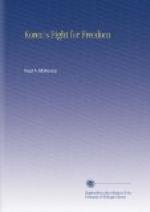The Japanese Foreign Minister at first refused even to see them. When at last they secured an audience, he told them bluntly that Japan was not going to war with China over the matter. “We are not ready yet,” said he. He then demanded of the reformers what they were going to do with themselves. This was too much for So Jai-pil. His seniors tried to restrain him, but in vain, “What way is this for Samurai to treat Samurai?” he hotly demanded. “We trusted you, and now you betray and forsake us. I have had enough of you. I am going to a new world, where men stand by their bonds and deal fairly with one another. I shall go to America.”
A few weeks later he landed in San Francisco, penniless. He knew scarcely any English. He sought work. His first job was to deliver circulars from door to door, and for this he was paid three dollars a day. He attended churches and meetings to learn how to pronounce the English tongue. He saved money enough to enter college, and graduated with honours. He became an American citizen, taking a new form of his name, Philip Jaisohn. He joined the United States Civil Service and in due course was made a doctor of medicine by Johns Hopkins University. He acquired a practice at Washington, and was lecturer for two medical schools. Later on, he was recalled to his native land.
The Korean reformers themselves saw, later on, the folly of their attempt. “We were very young,” they say. They were the tools of the Japanese Minister, and they had inherited a tradition of political life which made revolt seem the natural weapon by which to overthrow your enemies. They learned wisdom in exile, and some of them were subsequently to reach high rank in their country’s service.
There is a sequel to this story. The King and the Court regarded Kim Ok-kiun as the unpardonable offender. Other men might be forgiven, for after all attempted revolts were no novelties. But there was to be no forgiveness for Kim.
A price was put on his head. Assassins followed him to Japan, but could find no opportunity to kill him. Then a plot was planned and he was induced to visit Shanghai. He had taken great pains to conceal his visit, but everything had been arranged ahead for him. Arriving at Shanghai he was promptly slain, and his body was carried in a Chinese war-ship to Chemulpo. It was cut up, and exhibited in different parts of the land as the body of a traitor. The mortified Japanese could do nothing at the time.
Years passed. The Japanese now had control of Korea. One of the last things they did, in 1910, before contemptuously pushing the old Korean Government into limbo, was to make it issue an Imperial rescript, restoring Kim Ok-kiun, Hong Yung-sik and others—although long dead—to their offices and honours, and doing reverence to their memory.[1]




